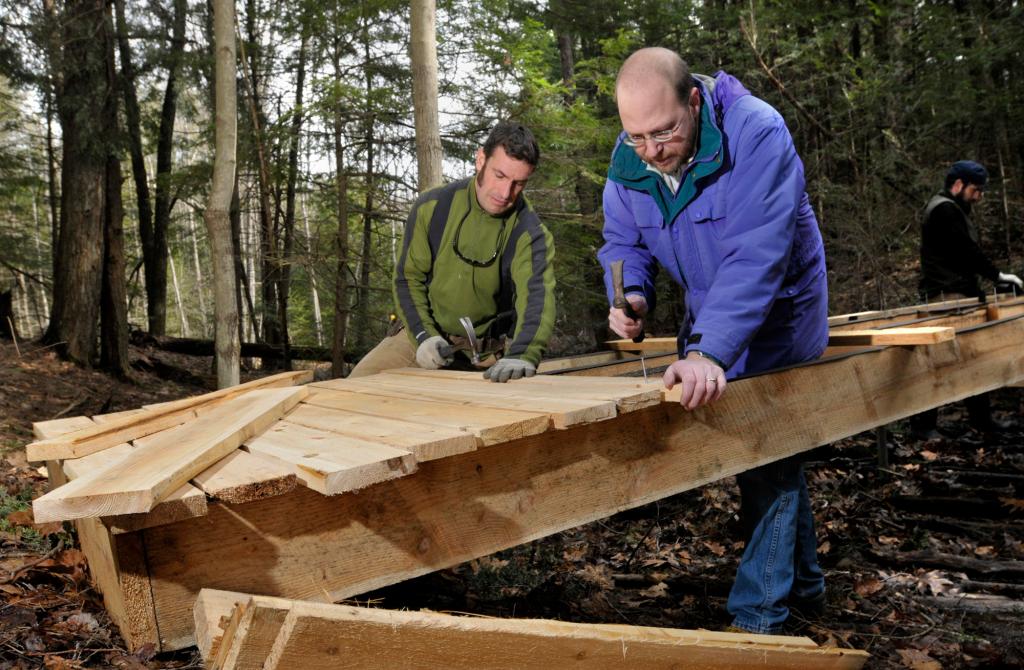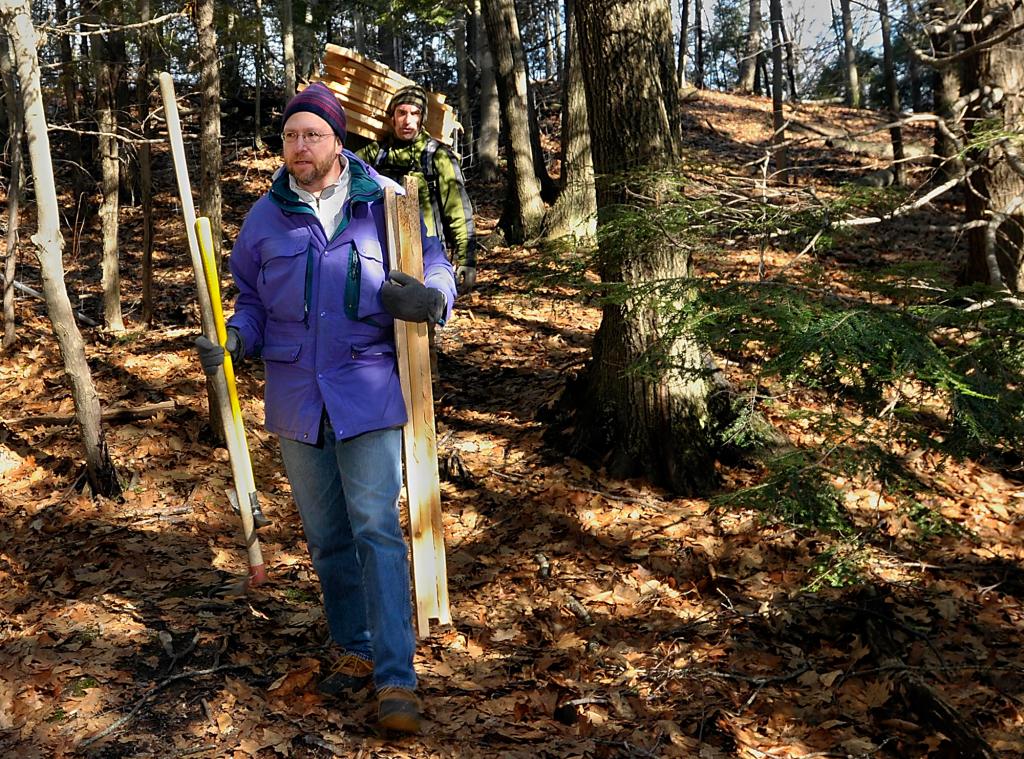PORTLAND — I found it a little ironic that as I followed Jaime Parker, trails manager for Portland Trails, he wasn’t following a trail.
I thought that a day helping Parker would be spent on nice, neatly manicured and easy-to-navigate trails. Paved maybe.
Instead, I quickly found myself up to my ankles in mud and fighting my way through a thicket of prickly brush.
“No, there’s no trail here, we’re just taking the fastest route,” said Parker, 38, as he carried a stack of seven or eight pieces of cedar boards through hip-high brush and weeds at the Fore River Sanctuary off Brighton Avenue. “We need to get to work.”
As trails manager for Portland Trails, Parker spends his days doing projects that help keep the nonprofit land trust’s 35 miles of trails around Greater Portland accessible.
Some trails are paved and urban, like the Eastern Prom Trail along Portland’s East End waterfront. Others wind through wild fields and woods, like the 80-acre Fore River Sanctuary, which includes one of Portland’s hidden natural gems, Jewel Falls.
On the day I met up with Parker, he and trails foreman Charlie Baldwin were starting to build a 24-foot-long footbridge over a tributary of the Fore River. It’s one of eight new footbridges the pair are building in the sanctuary this year.
While Parker and Baldwin carried six to eight boards each, plus tools and poles, I struggled with three boards and a metal rake as we walked about 10 minutes up and down hills to the bridge site.
One of the first things to be done was to drive 7-foot-long steel poles into the center of the stream bed, where they would be the central supports for the bridge.
Parker and I walked down into the stream, stepping on thin logs that had been put there by mountain bikers as a makeshift bridge.
Parker put one end of a pole into the stream and told me to hit the top of it with a sledgehammer. But the pole was taller than me, and I wasn’t sure how I was going to pound on it. I lifted the sledge over my head and did my best.
After about 10 whacks, the pole was about the height of my shoulders, but my shoulders and arms felt ready to fall off.
I gave it a few more whacks before the pole just refused to go any deeper. Then, Parker took the sledge and swung it with twice as much force as I had, whacking the pole down until it was the proper height for the bridge.
“Oh, you definitely ran into something down there,” said Parker, trying to make me feel better as I panted to catch my breath.
“Some days we’re doing a little bit of this kind of work, and some days we do this all day, and that will wear you out.”
I was worn out after 10 minutes with the sledgehammer. To catch my breath, I volunteered to go back and get more wood.
My first problem was that I couldn’t see the trail very well, with all the leaves, not to mention the fact that we hadn’t exactly taken the trail to get where we were. So I just followed our muddy footprints as best I could.
I found the lumber pile and was still out of breath when I picked up five or six 4-foot-long boards, cradling them under one arm. I slipped in the mud a couple of times, and lost my grip on the boards. So then I tried carrying them across the front of my body. But carrying them that way, I kept bumping into trees.
When I finally got back to Parker and Baldwin, they were building the frame of the bridge. I held some boards in place for Parker to hammer nails into.
Once the frame was done, I started nailing some of the floorboards onto the frame. Parker told me to leave about a thumb’s space between boards, so water and snow could run off between them. He also told me to drive the nails close to the end of the board, to avoid splitting the wood.
Standing in a couple of inches of water (don’t worry, I had rubber-soled L.L. Bean boots on) I began hammering and realized that my hands were still sore and vibrating a little from my sledgehammer experience.
I drove most of the nails without much problem, except for the occasional knot in the wood.
“Just take that one out and try another spot,” said Parker, when it was apparent that I was bending the nail. “Sometimes you can just bang it anyway, but maybe that one you should move.”
Parker came to Portland Trails after working in carpentry and landscaping, so building a bridge on a river is right up his alley. For me, it was the most complicated building project I had tackled since I built a railing on my front steps.
But Parker’s job isn’t all building; it’s basically doing whatever it takes to keep the trails clean and open.
Earlier in the day, he had picked up candy wrappers and cans off the trail. A day before that, he was hiking wooded trails, looking for damage in the wake of a fierce storm on Feb. 25. Other days, he prunes trees and bushes, so walkers or bikers don’t get a branch in the eye.
On rainy days, he might be in the Portland Trails office, planning new trails that the group hopes to develop, or getting permits for work that need to be done on trails.
“Every trail is different, so every day is different,” Parker said. “You can’t beat spending your workday out in the woods, or looking out at the ocean.”
I suppose you can’t, unless you could do those things without having to swing a sledgehammer.
Staff Writer Ray Routhier can be contacted at 791-6454 or at:
rrouthier@pressherald.com
Send questions/comments to the editors.





Success. Please wait for the page to reload. If the page does not reload within 5 seconds, please refresh the page.
Enter your email and password to access comments.
Hi, to comment on stories you must . This profile is in addition to your subscription and website login.
Already have a commenting profile? .
Invalid username/password.
Please check your email to confirm and complete your registration.
Only subscribers are eligible to post comments. Please subscribe or login first for digital access. Here’s why.
Use the form below to reset your password. When you've submitted your account email, we will send an email with a reset code.